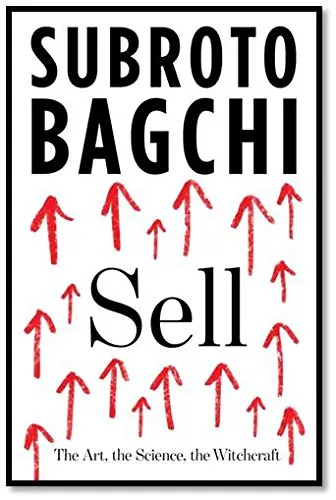Sales tips for entrepreneurs: Mindtree co-founder Subroto Bagchi on the art, science, and witchcraft of selling
Bestselling author Subroto Bagchi’s latest book offers 30 tips on effective selling, narrated in the form of short stories and interviews. Here are some key takeaways.

Effective and sustained selling is a key part of every organisation’s journey. From prospecting and pitching to deals and de-risking, this book offers a wealth of advice and experiences for businesses.
Subroto Bagchi co-founded Mindtree in 1999; his earlier IT services startup was Project21. He is the author of a number of business books, including The Elephant Catchers: Key lessons for breakthrough growth (see my book review), and now serves as Chairman of the Odisha Skill Development Authority.
Subroto’s latest book is Sell: The Art, The Science, The Witchcraft. The sprinkling of Hindi and Bengali in the short anecdotes and interviews would particularly appeal to Indian readers, but the lessons are global in nature. The context is largely the B2B setting of an IT services firm. But if you are looking for strategy maps, workflows, or checklists for sales, this is not the book for you.
See also my book review of Daniel Pink’s To Sell is Human: The Surprising Truth about Moving Others, which spells out six principles for effective sales: attunement, buoyancy, clarity, pitch, improvise, and serve. The books Let the Story Do the Work (Esther Choy) and The Storyteller’s Secret (Carmine Gallo) describe the use of storytelling techniques for entrepreneur pitches.
Here are my 14 clusters of takeaways from the book; the stories behind each tip in the book make for an entertaining read and bring out the human side of business interactions.
- What sales is – and is not
“Selling is no longer a profession in itself. It is a key component for professional success in every field,” Subroto begins. No matter what sector you are in, you will at some point need to make your view points heard, forge consensus, and gather formal commitment.
Unfortunately, sales is sometimes seen as an act of invasion, conmanship, or vested interest, Subroto observes. Good persuasive professionals have empathy, optimism, energy, resilience, resourcefulness, and persistence. “Sales is a definitive persuasion with an end goal,” Subroto defines.
“Selling is not a pushy, winner-take-all, macho act. It is an empathy-led, process-driven, knowledge-intensive discipline. Because, in the end, people buy from people,” he says. Selling is part art, part science, and part witchcraft.
Timing, confidence, character judgement, and emotional sensing are an art. The science of selling derives from neuroscience, imaging, and psychology; it also extends to machine learning in CRM, as seen in Amazon’s sales recommendations. The best sales experts or druids also have witchcraft or magic, and are able to deliver the seemingly impossible by almost casting a spell, Subroto explains.
Persuasion has elements of advice in it, not just victory. It involves sensing, respect, alignment, suspension of judgement, enquiry, and perspective. For sales professionals, it helps to have broad networks in various spheres to widen a sense of perspective and be able to connect to higher purposes.
- Prospecting
The journey of the sales process is also as exciting and fulfilling as the outcome. Prospecting can lead to new and unanticipated possibilities. In his early days of selling computers, Subroto would get insights about local businesses from hotel managers and chartered accountants; in his Wipro days, he would reach out to NRI associations during sales trips to the US.
“Many sales people settle down in their careers and gradually lose the ability to prospect,” cautions Subroto. “But the best salespeople never give up prospecting and cold calling because the process keeps their spirit of enquiry alive,” he explains.
- Segmentation and elimination
Start by casting a wide net, then narrow down whom to pitch to – and whom to avoid. One hilarious chapter describes how not to waste time or energy on those who are the great giver of homework (endless proofs of concept), patron saint of thought leadership (smart but not business savvy), and permanent prospect (never closes deals).
“You need to cut through the maze and locate the real prospects,” says Subroto. This requires sharp observation and good judgement of roles, character, career track, competence, expertise, influence, and authority.
- Belief
Sales professionals should go beyond logical facts and genuinely have the confidence that their offering adds business value beyond its production cost. “Your product must mean the world to you. If you cannot get yourself to be proud of it, do not sell it,” cautions Subroto.
This belief should be reinforced with the story of the brand and its values. For example, Marriott’s strong product promise is internalised by all its hotel staff. Starbucks sells not just coffee but the whole experience of a neighbourhood gathering place which is respectful to its employees and supports environmental causes such as the Rainforest Alliance.
- Customer aspiration and culture
Focus not just on the product features but how it meets the customer’s organisational culture and aspirations, and those of the customer’s customers. How can your sale increase their brand value?
Technology and sales are now global domains, and it helps to be aware of admirable business values in corporate cultures around the world. For instance, Swedes value inclusion, environmental sustainability, empowerment, diversity and equality – how many of these are reflected in your own team in your sales interaction with them?
Sales teams should co-create the solution with the customer, by bringing not just technology but value and excitement. Risk assessment should be realistic, and care and concern should be used in case there are errors like delivery delay. The deal doesn’t end with a signed contract; the customer also wants to know who the implementing project manager will be.
Communication should be clear, visual and well timed. Some sales professionals advise sending introductory emails not on Monday mornings, but on weekends or in the evening, when the decision makers are under less pressure.
- Digital media
Digital media has changed the way sales is done, in terms of inbound, outbound and background activities. The buyers have much more information than before, about tech trends, product performance, and sales professionals’ profiles.
Pay attention to your “Google quotient” and LinkedIn profiles, advises Subroto. Sales people now need to cultivate an affinity for data, and comb other sources like company websites, annual reports and analyst white papers. This helps make “informed calls” or “cold-warm calls.”
- Beyond sales: marketing and consulting
“The best sales people see themselves as consultants who can advise their clients, bring teams together to create a solution, and finally sell that solution with a consultative approach,” explains Scott Staples.
Sales people should leverage their marketing departments to build effective sales hooks that can make their customer pitch easy to understand and differentiated from the competition. This helps make “lased guided strikes” rather than “carpet bombing”, according to Paul Gottsengen.
Sales experts see each new proposal as their first, and do not take things for granted just because they have done similar deals before.
- Winning customer trust
Sales is a combination of physics (form, price), chemistry (relationship) and maths (profits), according to Vikram Kaul. His formula is Trust = (Familiarity X Expertise)/Risk.
“Increase the chemistry to improve the physics to deliver the maths,” says Vikram. Good relationships are built by researching, profiling, connecting, educating, engaging, and listening. “Familiarity is a competitive strength,” he adds.
“Customers like to deal with and buy from people who are comfortable being themselves,” says Bill Eggleston. You even need to know the name of your customer’s dog, he jokes.
- The pitch
Experienced sales professionals have exhaustive checklists for how to make the final presentation right. This includes pre-testing videos, rehearsing and timing the whole pitch, crediting data sources in slides, checking spelling, making eye contact, checking regularly for agreement, and including those joining online.
“Good presenters listen deeply before starting to answer questions. They reply in short sentences,” says Neo Mehra. They stick to the time limit even if it has been shortened due to unforeseen circumstances.
- Deal making
Deal making is like navigating the Arctic ice; you need to identify the key players on a continually shifting stage. Vikram Srivats describes a number of people involved in a deal from the customer side: vendor selection expert, buyer, sponsor, external expert, influencer, detractor, coach, lawyer, and even competitor.
It is important to track these changing roles even after the deal is won – or not. Root cause analysis must be used to understand why things did not work out as planned, advises Vikram.
The final contract should also be thoroughly checked for legal ramifications and correctness of cited research. “Never exaggerate your capacities or oversell yourself,” cautions Erwan Carpentier.
- Failure and mistakes
“In typical sales meets and conferences, the wins are given exaggerated attention and the losses are quickly buried under justifications and, sometimes, in a pointless blame game,” Subroto cautions.
Failure should be handled with tact, poise, reflection, authenticity and even brilliance. “Not many people know how to lose well,” he says. (See also my reviews of the books Failing to Succeed, Fail Fast, and Fail Better.)
Subroto illustrates this point beautifully by sharing a letter written by business director Natalie Smith after not winning a customer deal. The proof-of-concept team had merely delivered on the assignment without asking critical questions or questioning underlying assumptions. The letter to the customer thanked their team for all their insightful discussions, collaborative culture, specific activities, and technical excellence – while also requesting invitations for future bids.
Mistakes can occur due to project overruns, defective products or key employees leaving – leading to significant business loss by the customer. “No one expects you to be perfect. But you will be judged for your response to the situation,” according to Bruce Hoffmesiter, Marriott CIO.
Breaking the bad news to the customer must be done with authenticity, timeliness, assurance and follow-through, Subroto advises. Excuses, jargon, and avoidance will not work. Don’t interrupt the customer outburst; own the mess; show concern; convey a mitigation plan; seek customer inputs; offer to bear some of the loss costs; and show that you have learnt from the mistake.
- Gratitude
Sales teams should also cultivate a sense of gratitude. Lu Ellen stresses the need to show gratitude to all those who have helped you, in authentic, creative, and personalised ways. Edward Hoffman advises keeping a “gratitude list” or “gratitude journal” of who has helped you and how. Gratitude creates a sense of calm and is itself therapeutic.
Ways of such expression range include handwritten letters or art works, books suited to the person's profile, and even suggestions for names of charities to whom you will make a donation. Such gifts can be given to the customer and even to the colleagues who helped you win the deal.
- The ultimate champion
Rajeev Sawhney indentifies the qualities of the ultimate sales champions. They know where to play, how to play for the long game, and anticipate moves by the customer and the competition.
They ensure that they win along with the customer – not just the companies, but the individuals involved along the way. They introspect and draw lessons from victory as well as failure. Sales champions never slip into complacency, and always keep looking for the bigger picture even after a successful win (asking “why” seven times helps dig deeper and find larger opportunities).
They read extensively, practise a lot, and communicate well. “Reading dispels fear,” says Rajeev. “Practice is the sunlight that burns through the fog of fear,” he adds. Communication expertise is visible even in the quality of your silence when the customer is speaking.
- There are sales experts all around you
The book concludes by urging readers to look out for sales insights not just from corporate leaders but also from those whom you regularly buy from. This includes gardeners, photo printers, fruit sellers, fishmongers, shoe repairers, booksellers, and neighbourhood chefs.
For a true sales professional, sales is about what happens after you use the product – the transaction of buying and selling is an incidental process, Subroto signs off.







